Chris Eboch's Blog, page 10
January 10, 2020
YA Medieval Historical Fiction for #teachers or #homeschool @MvonHassell
This book came to my attention recently and it might be useful for homeschooling students or teachers looking for supplemental fiction about medieval Europe. And the Kindle version is only $.99, if you want to check it out!
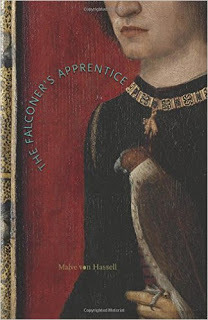 The Falconer's Apprenticeby Malve von Hassell
The Falconer's Apprenticeby Malve von Hassell
Andreas, an adventuresome 15-year old orphan, embarks on a precipitous flight across Europe to rescue the falcon Adela. A crotchety falconer, a secretive trader and his feisty daughter, a mysterious hermit, a young king in prison, an aging emperor, and an irascible Arab physician are among the principal characters in this action/adventure novel, set in the 13th century.
Written for readers age twelve and above, this coming-of-age story conveys life in medieval Europe, with bedbugs next to silver chalices, food ranging from the moldy to the sublime, and intellectual sophistication side by side with rank superstitions.
Original poetry by King Enzio, imprisoned in Bologna, and writings about falconry by Emperor Frederick II of Hohenstaufen are incorporated into the novel. The eight parts of the novel reflect the eight octagonal towers of the Castel del Monte, a critical turning point in the protagonist’s life.
Quote from a review:
"As I read, I was reminded of the old classic children's novels such as The Trumpeter of Krakow and The Door in the Wall. The lush historical details, the medieval time period, the characters who are good, brave young people trying to do the right thing during difficult times: these are books to be savored, not devoured. The Falconer's Apprentice fits right in with these Newbery Award winners. It's a fantastic book, one that parents can read to their entire family or that one person can enjoy at her leisure.
"I can see this being a terrific supplement for children/young adult studies of medieval European history."
Learn more at the author's website or Amazon.
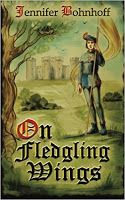 You might read this book with Jennifer Bohnhoff's
On Fledgling Wings
, another coming-of-age story set in medieval Europe.
You might read this book with Jennifer Bohnhoff's
On Fledgling Wings
, another coming-of-age story set in medieval Europe.
For more great historical fiction, visit the Mad about Middle Grade History blog (now defunct, but past posts are still useful).
 The Falconer's Apprenticeby Malve von Hassell
The Falconer's Apprenticeby Malve von HassellAndreas, an adventuresome 15-year old orphan, embarks on a precipitous flight across Europe to rescue the falcon Adela. A crotchety falconer, a secretive trader and his feisty daughter, a mysterious hermit, a young king in prison, an aging emperor, and an irascible Arab physician are among the principal characters in this action/adventure novel, set in the 13th century.
Written for readers age twelve and above, this coming-of-age story conveys life in medieval Europe, with bedbugs next to silver chalices, food ranging from the moldy to the sublime, and intellectual sophistication side by side with rank superstitions.
Original poetry by King Enzio, imprisoned in Bologna, and writings about falconry by Emperor Frederick II of Hohenstaufen are incorporated into the novel. The eight parts of the novel reflect the eight octagonal towers of the Castel del Monte, a critical turning point in the protagonist’s life.
Quote from a review:
"As I read, I was reminded of the old classic children's novels such as The Trumpeter of Krakow and The Door in the Wall. The lush historical details, the medieval time period, the characters who are good, brave young people trying to do the right thing during difficult times: these are books to be savored, not devoured. The Falconer's Apprentice fits right in with these Newbery Award winners. It's a fantastic book, one that parents can read to their entire family or that one person can enjoy at her leisure.
"I can see this being a terrific supplement for children/young adult studies of medieval European history."
Learn more at the author's website or Amazon.
 You might read this book with Jennifer Bohnhoff's
On Fledgling Wings
, another coming-of-age story set in medieval Europe.
You might read this book with Jennifer Bohnhoff's
On Fledgling Wings
, another coming-of-age story set in medieval Europe.For more great historical fiction, visit the Mad about Middle Grade History blog (now defunct, but past posts are still useful).
Published on January 10, 2020 03:00
January 8, 2020
Quick and Easy Steps to Finding Story and Article Ideas for #STORYSTORM
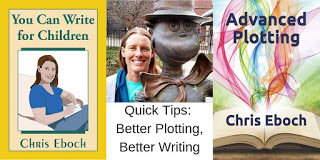 Jan is #STORYSTORM with Tara Lazar. Formerly known as #PiBoIdMo, the challenge is to come up with one new story idea each day of the month. How are you doing?
Jan is #STORYSTORM with Tara Lazar. Formerly known as #PiBoIdMo, the challenge is to come up with one new story idea each day of the month. How are you doing?Some writers have no trouble finding ideas, and only need to find enough time to tackle them all. But a couple members of my critique group have wondered what to write next. Sometimes the wellspring of ideas seems empty.
To brainstorm new ideas, sit down with a few sheets of paper and:
• Make a list of writing genres that you enjoy or would like to try — mysteries, fantasy, nonfiction articles, etc.
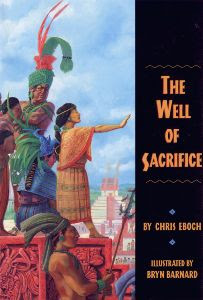 • On a new page, start jotting down your life experiences — jobs you’ve held, hobbies, sports, special interests, places you’ve lived or traveled — from childhood to the present. For example, the summer I spent traveling through Mexico and Central America inspired my Mayan historical drama,
The Well of Sacrifice
.
• On a new page, start jotting down your life experiences — jobs you’ve held, hobbies, sports, special interests, places you’ve lived or traveled — from childhood to the present. For example, the summer I spent traveling through Mexico and Central America inspired my Mayan historical drama,
The Well of Sacrifice
. • Add other subjects based on your family and friends’ experiences, anything interesting where you have an "in" for research. Do your kids play soccer? Is your husband a volunteer firefighter? Is one of your friends a graduate student studying lightning? Put it on the list.
• Now add subjects you would like to explore. If you’ve been meaning to take a Latin dance class or learn about Buddhism, add it to the list.
• Go back to the list and highlight any subjects that seem especially compelling. For example, my list would include working backstage in high school theater, and working as a glacier guide for a helicopter tour company. Those seem like natural settings for a story, even if I can’t think of a plot yet.
• Review the list of genres that interest you. Now go back over your highlighted subject list and consider each topic as it could relate to each genre. For example, I could write a fantasy set in the theater, or an action novel about a helicopter guide. Write each of these ideas on a new piece of paper, so you have room for notes.
• For each of your shortlist ideas, go back through your long list and see if you could add in another topic. Sometimes a single subject isn’t enough for a story or book, but mixing two or more subjects or ideas gives you a more fully fleshed concept. I got this from the late, brilliant children's book author Sid Fleischman. He once read that people born at midnight are supposed to be able to see ghosts. Later, had an idea about pirates who lost their treasure. He put these ideas together into his book The Ghost in the Noonday Sun. So consider moving your interesting subject to a new setting, or making your volunteer firefighter or lightning researcher into the main character.
• Keep adding to your list. Pay attention to the daily intrigues and surprises, and note them down. One night in Washington state, a friend and I went for a nighttime walk when dozens of little frogs were croaking and hopping along the road. I later sold a story to Highlights magazine about a father and child who explore a rainy night when the frogs were out.
• Pay attention to news and "human interest" stories as well. I saw an article about a helicopter crash, where everyone survived. I might use that as part of my action novel about the helicopter guide.
 • Don’t neglect nonfiction either. Would any of your subjects make for a lively article? If your kids play soccer, you could write a story about a soccer team. You could also write an article about the history of soccer, a how-to piece about a specific soccer techniques, a profile of a young star, a health article about preventing soccer injuries, or a parenting article about the pros and cons of competition in youth sports.
• Don’t neglect nonfiction either. Would any of your subjects make for a lively article? If your kids play soccer, you could write a story about a soccer team. You could also write an article about the history of soccer, a how-to piece about a specific soccer techniques, a profile of a young star, a health article about preventing soccer injuries, or a parenting article about the pros and cons of competition in youth sports.You might end this exercise with one or more ideas that have you fired up and ready to go. But in some cases, you’ll need more time to develop the concept before you start writing. Next week, I’ll discuss Turning an Idea into a Story. In the meantime, here are two more exercises to get the creative juices flowing:
Think about the most exciting, funny or scary thing that has happened to you. Make it into a story, changing the details to make it more dramatic.Ask a friend to tell you something exciting or scary or funny that has happened to him/her. Make it into a story, changing the details to make it more dramatic.
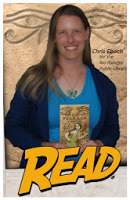 Chris Eboch is the author of over 40 books for children, including nonfiction and fiction, early reader through teen.
Chris Eboch is the author of over 40 books for children, including nonfiction and fiction, early reader through teen.Chris Eboch’s novels for ages nine and up include The Eyes of Pharaoh, a mystery in ancient Egypt; The Well of Sacrifice, a Mayan adventure; The Genie’s Gift, a middle eastern fantasy; and the Haunted series, about kids who travel with a ghost hunter TV show, which starts with The Ghost on the Stairs.
Her writing craft books include You Can Write for Children: How to Write Great Stories, Articles, and Books for Kids and Teenagers, and Advanced Plotting. Learn more at www.chriseboch.comor her Amazon page.
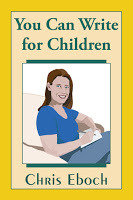 Get more advice on finding ideas, developing those ideas, and polishing your manuscripts in
You Can Write for Children
: How to Write Great Stories, Articles, and Books for Kids and Teenagers, available for the Kindle, in paperback, or in Large Print paperback.
Get more advice on finding ideas, developing those ideas, and polishing your manuscripts in
You Can Write for Children
: How to Write Great Stories, Articles, and Books for Kids and Teenagers, available for the Kindle, in paperback, or in Large Print paperback.Advanced Plotting is designed for the intermediate and advanced writer. If you struggle with plot or suspect your plotting needs work, this book can help. Use the Plot Outline Exercise to identify and fix plot weaknesses. Learn how to get off to a fast start, prop up a sagging middle, build to a climax, improve your pacing, and more.
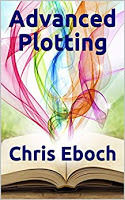 This really is helping me a lot. It’s written beautifully and to-the-point. The essays really help you zero in on your own problems in your manuscript. The Plot Outline Exercise is a great tool!
This really is helping me a lot. It’s written beautifully and to-the-point. The essays really help you zero in on your own problems in your manuscript. The Plot Outline Exercise is a great tool!I just read and—dissected—your well written book: Advanced Plotting. It’s now highlighted in bright orange and littered with many of those little 3M sticky labels. GOOD JOB. There are too many just-for-beginners books out there. Yours was a delight.
Published on January 08, 2020 05:10
December 21, 2019
Last-Minute #Christmas Gift Ideas for #Writing Friends #amwriting
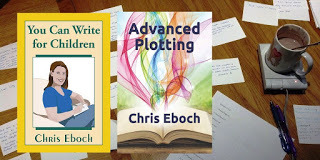 With Christmas only a few days away, maybe you realize you need an extra gift or two. Did you know you can purchase a Kindle book for someone and have it delivered on Christmas?
With Christmas only a few days away, maybe you realize you need an extra gift or two. Did you know you can purchase a Kindle book for someone and have it delivered on Christmas? You can do this even if you don't have a Kindle. If they don't have a Kindle, they can read the book on the Kindle app. They can also exchange it for something else of equal value.
 If you have writing friends – or people who have expressed an interest in writing but don't know how to start – may I suggest Advanced Plotting or You Can Write for Children: How to Write Great Stories, Articles, and Books for Kids and Teenagers?
If you have writing friends – or people who have expressed an interest in writing but don't know how to start – may I suggest Advanced Plotting or You Can Write for Children: How to Write Great Stories, Articles, and Books for Kids and Teenagers?
Published on December 21, 2019 04:00
December 9, 2019
#Holiday Gift Guide: #Writing Advice! #amwriting
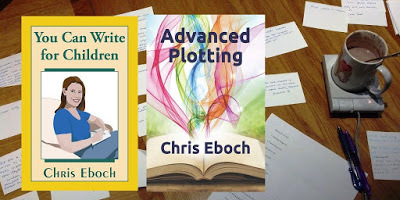 You Can Write for Children: How to Write Great Stories, Articles, and Books for Kids and Teenagers:
You Can Write for Children: How to Write Great Stories, Articles, and Books for Kids and Teenagers: When you write for children, you have the most appreciative audience in the world. But to reach that audience, you need to write fresh, dynamic stories, whether you’re writing rhymed picture books, middle grade mysteries, edgy teen novels, nonfiction, or something else.

Learn how to find ideas and develop those ideas into stories, articles, and books. Understand the basics of character development, plot, setting, and theme – and some advanced elements, along with how to use point of view, dialogue, and thoughts. Finally, learn about editing your work and getting critiques.
You Can Write for Children : How to Write Great Stories, Articles, and Books for Kids and Teenagers is available for the Kindle, in paperback, or in Large Print paperback.
 Advanced Plotting is designed for the intermediate and advanced writer: you’ve finished a few manuscripts, read books and articles on writing, taken some classes, attended conferences. But you still struggle with plot, or suspect that your plotting needs work. This book can help.
Advanced Plotting is designed for the intermediate and advanced writer: you’ve finished a few manuscripts, read books and articles on writing, taken some classes, attended conferences. But you still struggle with plot, or suspect that your plotting needs work. This book can help.This really is helping me a lot. It's written beautifully and to-the-point. The essays really help you zero in on your own problems in your manuscript. The Plot Outline Exercise is a great tool!
I just read and—dissected—your well written book: Advanced Plotting. It's now highlighted in bright orange and littered with many of those little 3M sticky labels. GOOD JOB. There are too many just-for-beginners books out there. Yours was a delight.
See these and more at www.chriseboch.com or my Amazon page.
Published on December 09, 2019 05:00
December 7, 2019
Write Better Next Year - #WritingTips
 Get Advanced Plotting from Amazon in print or ebook.The holiday season can be a crazy time, when it’s hard to get any writing done. Still, it’s not too early to think about your writing goals next year.
Get Advanced Plotting from Amazon in print or ebook.The holiday season can be a crazy time, when it’s hard to get any writing done. Still, it’s not too early to think about your writing goals next year. Maybe you have a NaNoWriMo manuscript to edit and polish.Or perhaps you have other projects that could use a boost before you send them out. Consider giving yourself the gift of improved writing knowledge, so you can reach your goals for the new year!
If you need help shaping your novel, or identifying problems, consider getting a professional critique. You can find my rates and recommendations here (short version: developmental/content editing at $2 per page for a novel, $40 for a picture book).
Stacy Whitman, Editorial Director of Tu Books, provided this list of professional editors who work directly with authors. Karen Sanderson, "The Word Shark," is an editor and proofreader who also has an Editor Spotlight series on her blog.
Writing books on writing is its own industry, providing many books that can give you advice on every aspect of writing.

Advanced Plotting is designed for the intermediate and advanced writer: you’ve finished a few manuscripts, read books and articles on writing, taken some classes, attended conferences. But you still struggle with plot, or suspect that your plotting needs work.
This book can help.
The Plot Outline Exercise is designed to help a writer work with a completed manuscript to identify and fix plot weaknesses. It can also be used to help flesh out an outline. Additional articles address specific plot challenges, such as getting off to a fast start, propping up a sagging middle, building to a climax, and improving your pacing. A dozen guest authors share advice from their own years of experience.
Read the book straight through, study the index to find help with your current problem, or dip in and out randomly — however you use this book, you’ll find fascinating insights and detailed tips to help you build a stronger plot and become a better writer.
"This really is helping me a lot. It’s written beautifully and to-the-point. The essays really help you zero in on your own problems in your manuscript. The Plot Outline Exercise is a great tool!"
Here are some other writing craft books I like. The links are to the authors’ websites or blogs. If you want to buy, it might be faster to go to your favorite online retailer and paste in the name, or ask your local bookstore to order the book.
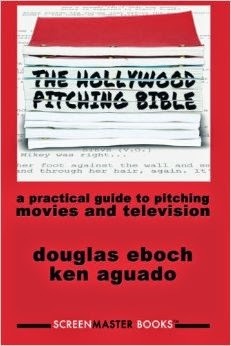 My brother, scriptwriter Douglas Eboch, is co-author of
The Hollywood Pitching Bible
. While it’s targeted at scriptwriters wanting to sell screenplays, a lot of the material is helpful and interesting to novelists as well, especially if you are trying to find your book’s “hook” or write a query/synopsis.
My brother, scriptwriter Douglas Eboch, is co-author of
The Hollywood Pitching Bible
. While it’s targeted at scriptwriters wanting to sell screenplays, a lot of the material is helpful and interesting to novelists as well, especially if you are trying to find your book’s “hook” or write a query/synopsis.Self-Editing for Fiction Writers , by Renni Browne and Dave King is one of my favorite writing craft books. Each chapter covers a specific tip for improving your style, and exercises at the end (with answers in the back) help you see if you are really “getting it.”
There’s a good book by Nancy Sanders called Yes! You Can Learn How to Write Children’s Books, Get Them Published, and Build a Successful Writing Career , which points out that we typically write for three reasons – the emotional satisfaction of getting published, to make money, and for the love of writing. She suggests separating those three goals, so you don’t put pressure on yourself to sell what you are writing for love, and you find more practical ways of approaching the other two goals. She then addresses how to target each goal.
Nancy also has Yes! You Can Learn How to Write Beginning Readers and Chapter Books.
The Idiot’s Guide to Children’s Book Publishing , by Harold Underdown, is an excellent overview of the business. It explains the different genres, the difference between a magazine story and a picture book manuscript, how to find a publisher, etc.
Scene and Structure, by Jack Bickham, has a lot of good advice on pacing. Plot & Structure, by James Scott Bell, may also be of interest. Both of these are published by Writers Digest.
I found some interesting tidbits in Manuscript Makeover, by Elizabeth Lyon.
The Emotion Thesaurus: A Writer’s Guide To Character Expression, by Angela Ackerman, is often recommended.
I’ve heard several authors talk about Hooked: Write Fiction That Grabs Readers at Page One, by Les Edgerton and The First Five Pages: A Writer’s Guide To Staying Out of the Rejection Pile, by Noah Lukeman.
I’m a big fan of using close/deep point of view. Jill Elizabeth Nelson has a book called Rivet Your Readers with Deep POV.
And if you need help with grammar (or know someone who does), these have been recommended by writing teachers I know:
Things That Make Us (Sic), by Martha BrockenbroughEats, Shoots, and Leaves: The Zero Tolerance Approach to Punctuation by Lynne TrussPainless Grammar, by Rebecca ElliottGrammatically Correctby Anne Stilman
 Please share your other favorite books in the comments. I hope you’ll be able to give yourself some writing gifts this year – and perhaps share the knowledge with other aspiring writers you know!
Please share your other favorite books in the comments. I hope you’ll be able to give yourself some writing gifts this year – and perhaps share the knowledge with other aspiring writers you know!Chris Eboch’s novels for ages nine and up include The Eyes of Pharaoh, a mystery in ancient Egypt; The Well of Sacrifice, a Mayan adventure; The Genie’s Gift, a middle eastern fantasy; and the Haunted series, about kids who travel with a ghost hunter TV show.
Her writing craft books include You Can Write for Children: How to Write Great Stories, Articles, and Books for Kids and Teenagers, and Advanced Plotting. Learn more at www.chriseboch.com or her Amazon page.
Published on December 07, 2019 06:00
December 3, 2019
#Holiday Gift Guide – Great Books for Middle Grade Readers #Christmas
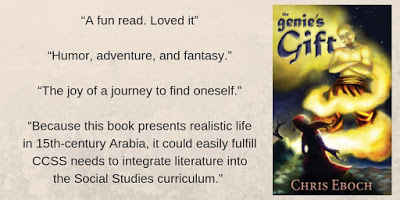
Middle Grade Novels with History
Oh the weather outside is… not that bad here, actually, but it’s still feeling like the holiday season is in full swing. If you have a young reader on your shopping list, consider one of these titles from Chris Eboch, appropriate for ages 8 to 15.
The Genie’s Gift
This lighthearted action novel set in the fifteenth-century Middle East draws on the mythology of The Arabian Nights. Shy and timid Anise determines to find the Genie Shakayak and claim the Gift of Sweet Speech. But the way is barred by a series of challenges, both ordinary and magical. How will Anise get past a vicious she-ghoul, a sorceress who turns people to stone, and mysterious sea monsters, when she can’t even speak in front of strangers?
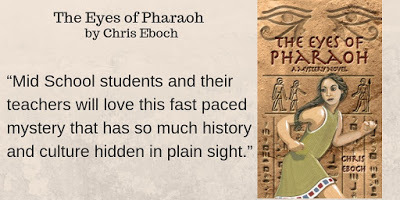 The Eyes of Pharaoh
Ancient Egypt in 1177 BC comes to life. When Reya hints that Egypt is in danger from foreign nomads, Seshta and Horus don’t take him seriously. How could anyone challenge Egypt? Then Reya disappears. To save their friend, Seshta and Horus spy on merchants, soldiers, and royalty, and start to suspect even The Eyes of Pharaoh, the powerful head of the secret police. Will Seshta and Horus escape the traps set for them, rescue Reya, and stop the plot against Egypt in time? See this and more at www.chriseboch.com or her Amazon page.
The Eyes of Pharaoh
Ancient Egypt in 1177 BC comes to life. When Reya hints that Egypt is in danger from foreign nomads, Seshta and Horus don’t take him seriously. How could anyone challenge Egypt? Then Reya disappears. To save their friend, Seshta and Horus spy on merchants, soldiers, and royalty, and start to suspect even The Eyes of Pharaoh, the powerful head of the secret police. Will Seshta and Horus escape the traps set for them, rescue Reya, and stop the plot against Egypt in time? See this and more at www.chriseboch.com or her Amazon page.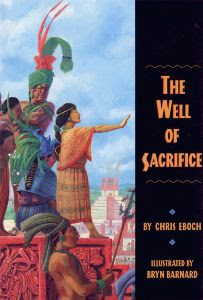 The Well of Sacrifice
The Well of Sacrifice A Mayan girl in ninth-century Guatemala rebels against the High Priest who sacrifices anyone challenging his power.
Kirkus Reviews called The Well of Sacrifice, “[An] engrossing first novel….Eboch crafts an exciting narrative with a richly textured depiction of ancient Mayan society….The novel shines not only for a faithful recreation of an unfamiliar, ancient world, but also for the introduction of a brave, likable and determined heroine.”
Watching this unorthodox 12-year-old girl outwit a high priest, escape jail, rescue her sister and more makes for a fast-paced read. An author’s note describes the historical context for the tale. - Publishers Weekly
 Jesse Owens: Young Record Breaker and Milton Hershey: Young Chocolatier
Jesse Owens: Young Record Breaker and Milton Hershey: Young Chocolatier These inspirational biographies in Simon and Schuster’s Childhood of Famous Americans series are written under the name M.M. Eboch.
Jesse Owens would be especially suitable for young athletes, while Milton Hershey might appeal to kids who struggle in school, as Milton did. They are full-length books at a middle grade interest level, but written at a third-grade reading level.
See these and more at www.chriseboch.com or her Amazon page.
Middle Grade Contemporary Novels
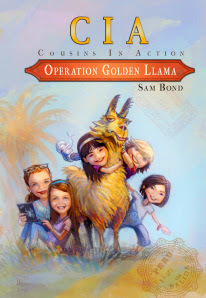 The Cousins in Action Series by Sam Bond begins with Operation Golden Llama
The Cousins in Action Series by Sam Bond begins with Operation Golden LlamaDumped at their eccentric Grandma’s, Cagney, Olivia, Aidan, Lissy and Tess are convinced they’re in for a boring summer. But when Grandma gets a series of mysterious phone calls, and a highly unlikely pet sitter arrives, the cousins find themselves jetting off to Peru, where much to their surprise they find their adventures have only just begun.
You'll want the sequels, Operation Tiger Paw, Operation Jewel Thief, Operation Pharaoh’s Curse, and Operation Dude Ranch!
Visit Sam Bond’s website or her Amazon page.
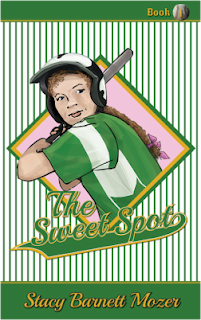 The Sweet Spot, by Stacy Barnett Mozer
The Sweet Spot, by Stacy Barnett MozerWhen thirteen-year-old Sam Barrette’s baseball coach tells her that her attitude’s holding her back, she wants to hit him in the head with a line drive. All stakes now rest on Sam’s performance at baseball training camp. Placed at the bottom with the weaker players, she will have to work her way up to A league, not just to show Coach that she can be the best team player possible, but to prove to herself that she can hold a bat with the All-Star boys.
Don't miss the follow-up novel, The Perfect Trip, a road trip adventure!
Visit Stacy Barnett Mozer’s website or her Amazon page.
Middle Grade Contemporary Fantasy Novels
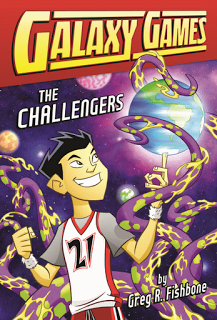 The Galaxy Games Series by Greg Fishbone:
The Galaxy Games Series by Greg Fishbone:The Challengers
Things are looking up for Tyler Sato (literally!) as he and his friends scan the night sky for a star named for him by his Tokyo cousins in honor of his eleventh birthday. Ordinary stars tend to stay in one place, but Ty’s seems to be streaking directly toward Earth at an alarming rate. Soon the whole world is talking about TY SATO, the doomsday asteroid, and life is turned upside down for Ty Sato, the boy, who would rather be playing hoops in his best friend’s driveway….
The Amorphous Assassin
Thirteen-year-old Tyler Sato has lied, cheated, and scammed his way into the Galaxy Games. Now, on the eve of the galaxy-spanning sports tournament, Tyler’s past is catching up…with a vengeance!Earth’s team of international all-stars is at each other’s throats. A shadowy conspiracy is on the move. And a shape-shifting alien assassin has Tyler in his sights.
Can Tyler step up his game to become the leader Earth needs? Or will the world finally discover that Tyler isn’t quite the hero that everyone believes?
Visit Greg Fishbone’s website or his Amazon page.
The Magic Mayhem Series by D. D. Roy
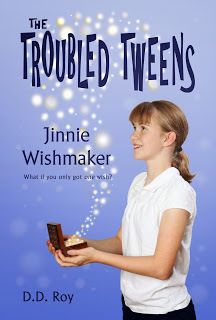 Jinnie Wishmaker
Jinnie WishmakerSix-time USA Today bestselling author Deanna Roy mixes adventure and magic in her first series for middle grade readers. In Jinnie Wishmaker, an eleven-year-old girl discovers she can grant any living thing its one true wish. The trouble is, once she grants the wish, she can’t control the results.
Get the sequels, Marcus Mender and Elektra Chaos.
The Magic Mayhem series begins with Jinnie Wishmaker. However, each book can be read as a standalone book.
Visit Deanna Roy’s blog or the Magic Mayhem Amazon page.
Published on December 03, 2019 08:30
#Holiday Gift Guide – Great Books for Middle Grade Readers
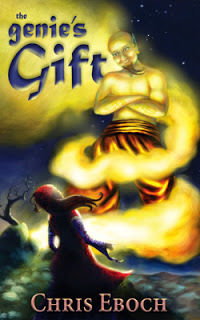
Middle Grade Novels with History
Oh the weather outside is… not that bad here, actually, but it’s still feeling like the holiday season is in full swing. If you have a young reader on your shopping list, consider one of these titles from Chris Eboch, appropriate for ages 8 to 15.
The Genie’s Gift
This lighthearted action novel set in the fifteenth-century Middle East draws on the mythology of The Arabian Nights. Shy and timid Anise determines to find the Genie Shakayak and claim the Gift of Sweet Speech. But the way is barred by a series of challenges, both ordinary and magical. How will Anise get past a vicious she-ghoul, a sorceress who turns people to stone, and mysterious sea monsters, when she can’t even speak in front of strangers?
 The Well of Sacrifice
The Well of Sacrifice A Mayan girl in ninth-century Guatemala rebels against the High Priest who sacrifices anyone challenging his power.
Kirkus Reviews called The Well of Sacrifice, “[An] engrossing first novel….Eboch crafts an exciting narrative with a richly textured depiction of ancient Mayan society….The novel shines not only for a faithful recreation of an unfamiliar, ancient world, but also for the introduction of a brave, likable and determined heroine.”
Watching this unorthodox 12-year-old girl outwit a high priest, escape jail, rescue her sister and more makes for a fast-paced read. An author’s note describes the historical context for the tale. - Publishers Weekly
 Jesse Owens: Young Record Breaker and Milton Hershey: Young Chocolatier
Jesse Owens: Young Record Breaker and Milton Hershey: Young Chocolatier These inspirational biographies in Simon and Schuster’s Childhood of Famous Americans series are written under the name M.M. Eboch.
Jesse Owens would be especially suitable for young athletes, while Milton Hershey might appeal to kids who struggle in school, as Milton did. They are full-length books at a middle grade interest level, but written at a third-grade reading level.
See these and more at www.chriseboch.com or her Amazon page.
Middle Grade Contemporary Novels
 The Cousins in Action Series by Sam Bond begins with Operation Golden Llama
The Cousins in Action Series by Sam Bond begins with Operation Golden LlamaDumped at their eccentric Grandma’s, Cagney, Olivia, Aidan, Lissy and Tess are convinced they’re in for a boring summer. But when Grandma gets a series of mysterious phone calls, and a highly unlikely pet sitter arrives, the cousins find themselves jetting off to Peru, where much to their surprise they find their adventures have only just begun.
You'll want the sequels, Operation Tiger Paw, Operation Jewel Thief, Operation Pharaoh’s Curse, and Operation Dude Ranch!
Visit Sam Bond’s website or her Amazon page.
 The Sweet Spot, by Stacy Barnett Mozer
The Sweet Spot, by Stacy Barnett MozerWhen thirteen-year-old Sam Barrette’s baseball coach tells her that her attitude’s holding her back, she wants to hit him in the head with a line drive. All stakes now rest on Sam’s performance at baseball training camp. Placed at the bottom with the weaker players, she will have to work her way up to A league, not just to show Coach that she can be the best team player possible, but to prove to herself that she can hold a bat with the All-Star boys.
Don't miss the follow-up novel, The Perfect Trip, a road trip adventure!
Visit Stacy Barnett Mozer’s website or her Amazon page.
Middle Grade Contemporary Fantasy Novels
 The Galaxy Games Series by Greg Fishbone:
The Galaxy Games Series by Greg Fishbone:The Challengers
Things are looking up for Tyler Sato (literally!) as he and his friends scan the night sky for a star named for him by his Tokyo cousins in honor of his eleventh birthday. Ordinary stars tend to stay in one place, but Ty’s seems to be streaking directly toward Earth at an alarming rate. Soon the whole world is talking about TY SATO, the doomsday asteroid, and life is turned upside down for Ty Sato, the boy, who would rather be playing hoops in his best friend’s driveway….
The Amorphous Assassin
Thirteen-year-old Tyler Sato has lied, cheated, and scammed his way into the Galaxy Games. Now, on the eve of the galaxy-spanning sports tournament, Tyler’s past is catching up…with a vengeance!Earth’s team of international all-stars is at each other’s throats. A shadowy conspiracy is on the move. And a shape-shifting alien assassin has Tyler in his sights.
Can Tyler step up his game to become the leader Earth needs? Or will the world finally discover that Tyler isn’t quite the hero that everyone believes?
Visit Greg Fishbone’s website or his Amazon page.
The Magic Mayhem Series by D. D. Roy
 Jinnie Wishmaker
Jinnie WishmakerSix-time USA Today bestselling author Deanna Roy mixes adventure and magic in her first series for middle grade readers. In Jinnie Wishmaker, an eleven-year-old girl discovers she can grant any living thing its one true wish. The trouble is, once she grants the wish, she can’t control the results.
Get the sequels, Marcus Mender and Elektra Chaos.
The Magic Mayhem series begins with Jinnie Wishmaker. However, each book can be read as a standalone book.
Visit Deanna Roy’s blog or the Magic Mayhem Amazon page.
Published on December 03, 2019 05:00
November 16, 2019
Strong Writing: Raising the Stakes #NaNoWriMo
 Get Advanced Plotting from Amazon in print or ebook.Are you doing #NaNoWriMo? You may be hitting a slump. What happens next? How can you keep the story going strong? Let’s talk about the stakes – and how to raise them.
Get Advanced Plotting from Amazon in print or ebook.Are you doing #NaNoWriMo? You may be hitting a slump. What happens next? How can you keep the story going strong? Let’s talk about the stakes – and how to raise them.Look at your main story problem. What are the stakes? Do you have positive stakes (what the main character will get if he succeeds), negative stakes (what the MC will suffer if he fails), or both? Could the penalty for failure be worse? Your MC should not be able to walk away without penalty. Otherwise the problem was obviously not that important or difficult. The penalty can be anything from personal humiliation to losing the love interest to the destruction of the world – depending on the length of story and audience age – so long as you have set up how important that is for your MC.
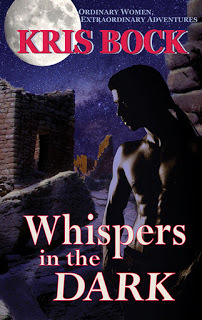 Are things worse at page 200?Note that those complications should also be both Difficult and Important. Say you have a character who needs to get somewhere by a specific time, and you want to increase tension by causing delays. If she simply runs into a series of chatty neighbors, it’s quickly going to get boring (unless you can push it to the point of comedy).
Are things worse at page 200?Note that those complications should also be both Difficult and Important. Say you have a character who needs to get somewhere by a specific time, and you want to increase tension by causing delays. If she simply runs into a series of chatty neighbors, it’s quickly going to get boring (unless you can push it to the point of comedy). Instead, find delays that are dramatic and important to the main character. Her dog slips out of the house while she’s distracted, and she’s worried that he’ll get hit by a car if she doesn’t get him back inside... Her best friend shows up and insists that they talk about something important NOW or she won’t be friends anymore....
Ideally, these complications also relate to the main problem or a subplot. The best friend’s delay will have more impact if it’s tied into a subplot involving tension between the two friends rather than coming out nowhere.
Here’s another important point -- you must keep raising the stakes, making each encounter different and more dramatic. You move the story forward by moving the main character farther back from her goal, according to Jack M. Bickham in his writing instruction book Scene and Structure
 :
: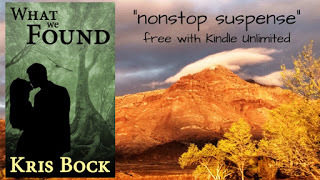 “Well-planned scenes end with disasters that tighten the noose around the lead character’s neck; they make things worse, not better; they eliminate hoped-for avenues of progress; they increase the lead character’s worry, sense of possible failure, and desperation – so that in all these ways the main character in a novel of 400 pages will be in far worse shape by page 200 than he seemed to be at the outset.”
“Well-planned scenes end with disasters that tighten the noose around the lead character’s neck; they make things worse, not better; they eliminate hoped-for avenues of progress; they increase the lead character’s worry, sense of possible failure, and desperation – so that in all these ways the main character in a novel of 400 pages will be in far worse shape by page 200 than he seemed to be at the outset.” If the tension is always high, but at the same height, you still have a flat line. Instead, think of your plot as going in waves. Each scene is a mini-story, building to its own climax -- the peak of the wave. You may have a breather, a calmer moment, after that climax. But each scene should lead to the next, and drive the story forward, so all scenes connect and ultimately drive toward the final story climax.
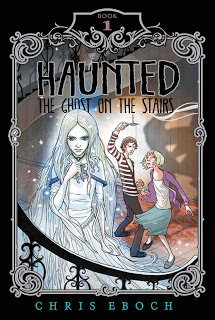 Example: In the Haunted books, the kids have a time limit for helping the ghosts, because their parents’ ghost hunter TV show is only shooting for a few days. But the stakes also rise as the kids get more involved with the ghosts, and understand their tragic plights. Complications come from human meddlers – the fake psychic who wants to take credit, the mean assistant who thinks kids are troublemakers, and Mom, who worries and wants to keep the kids away from anything dangerous.
Example: In the Haunted books, the kids have a time limit for helping the ghosts, because their parents’ ghost hunter TV show is only shooting for a few days. But the stakes also rise as the kids get more involved with the ghosts, and understand their tragic plights. Complications come from human meddlers – the fake psychic who wants to take credit, the mean assistant who thinks kids are troublemakers, and Mom, who worries and wants to keep the kids away from anything dangerous.Exercise: take one of your story ideas. Outline a plot that escalates the problem.

Advanced Plotting has tons of advice on building strong plots. Advanced Plotting is available from Amazon(paperback or Kindle, free in KU) or Barnes & Noble (paperback).
You Can Write for Children : How to Write Great Stories, Articles, and Books for Kids and Teenagers is available for the Kindle, in paperback, or in Large Print paperback.
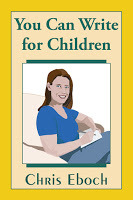 Chris Eboch is the author of over 60 books for children, including nonfiction and fiction, early reader through teen. Her novels for ages nine and up include The Eyes of Pharaoh, a mystery in ancient Egypt; The Well of Sacrifice, a Mayan adventure; The Genie’s Gift, a middle eastern fantasy; and the Haunted series, about kids who travel with a ghost hunter TV show, which starts with The Ghost on the Stairs.
Chris Eboch is the author of over 60 books for children, including nonfiction and fiction, early reader through teen. Her novels for ages nine and up include The Eyes of Pharaoh, a mystery in ancient Egypt; The Well of Sacrifice, a Mayan adventure; The Genie’s Gift, a middle eastern fantasy; and the Haunted series, about kids who travel with a ghost hunter TV show, which starts with The Ghost on the Stairs. Learn more at https://chriseboch.com/or her Amazon page.
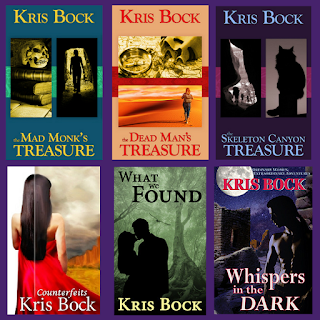 Chris also writes for adults under the name Kris Bock. Kris Bock novels are action-packed romantic adventures set in Southwestern landscapes. Fans of Mary Stewart, Barbara Michaels, and Terry Odell will want to check out Kris Bock’s romantic adventures. “Counterfeits is the kind of romantic suspense novel I have enjoyed since I first read Mary Stewart’s Moonspinners.” 5 Stars – Roberta at Sensuous Reviews blog
Chris also writes for adults under the name Kris Bock. Kris Bock novels are action-packed romantic adventures set in Southwestern landscapes. Fans of Mary Stewart, Barbara Michaels, and Terry Odell will want to check out Kris Bock’s romantic adventures. “Counterfeits is the kind of romantic suspense novel I have enjoyed since I first read Mary Stewart’s Moonspinners.” 5 Stars – Roberta at Sensuous Reviews blogRead excerpts at www.krisbock.comor visit her Amazon page. Sign up for the Kris Bock newsletter for announcements of new books, sales, and more.
Published on November 16, 2019 04:00
July 6, 2019
How to Write Vivid Scenes Part 3 #amwriting
 Here’s part three of How to Write Vivid Scenesfrom Advanced Plotting.
Here’s part three of How to Write Vivid Scenesfrom Advanced Plotting.
Cause and Effect
One of the ironies of writing fiction is that fiction has to be more realistic than real life. In real life, things often seem to happen for no reason. In fiction, that comes across as unbelievable. We expect stories to follow a logical pattern, where a clear action causes a reasonable reaction. In other words, cause and effect.
The late Jack M. Bickham explored this pattern in Scene & Structure, from Writer’s Digest Books. He noted that every cause should have an effect, and vice versa. This goes beyond the major plot action and includes a character’s internal reaction. When action is followed by action with no internal reaction, we don’t understand the character’s motives. At best, the action starts to feel flat and unimportant, because we are simply watching a character go through the motions without emotion. At worst, the character’s actions are unbelievable or confusing.
In Manuscript Makeover (Perigee Books), Elizabeth Lyon suggests using this pattern: stimulus — reaction/emotion — thoughts — action.
 Something happens to your main character (the stimulus); You show his emotional reaction, perhaps through dialog, an exclamation, gesture, expression, or physical sensation; He thinks about the situation and makes a decision on what to do next;
Something happens to your main character (the stimulus); You show his emotional reaction, perhaps through dialog, an exclamation, gesture, expression, or physical sensation; He thinks about the situation and makes a decision on what to do next;Finally, he acts on that decision.
This lets us see clearly how and why a character is reacting. The sequence may take one sentence or several pages, so long as we see the character’s emotional and intellectual reaction, leading to a decision.
Building Strong Scenes
Bickham offered these suggestions for building strong scenes showing proper cause and effect:
The stimulus must be external — something that affects one of the five senses, such as action or dialog that could be seen or heard.
The response should also be partly external. In other words, after the character’s emotional response, she should say or do something. (Even deciding to say nothing leads to a reaction we can see, as the character turns away or stares at the stimulus or whatever.)
The response should immediately follow the stimulus. Wait too long and the reader will lose track of the original stimulus, or else wonder why the character waited five minutes before reacting.
 Be sure you word things in the proper order. If you show the reaction before the action, it’s confusing: “Lisa hurried toward the door, hearing pounding.” For a second or two, we don’t know why she’s hurrying toward the door. In fact, we get the impression that Lisa started for the door beforeshe heard the pounding. Instead, place the stimulus first: “Pounding rattled the door. Lisa hurried toward it.”
Be sure you word things in the proper order. If you show the reaction before the action, it’s confusing: “Lisa hurried toward the door, hearing pounding.” For a second or two, we don’t know why she’s hurrying toward the door. In fact, we get the impression that Lisa started for the door beforeshe heard the pounding. Instead, place the stimulus first: “Pounding rattled the door. Lisa hurried toward it.”If the response is not obviously logical, you must explain it, usually with the responding character’s feelings/thoughts placed between the stimulus and the response. Here’s an example where the response is not immediately logical:
Knocking rattled the door. (Stimulus)Lisa waited, staring at the door. (Action)
Why is she waiting? Does she expect someone to just walk in, even though they are knocking? Is she afraid? Is this not her house? To clarify, include the reaction:
Knocking rattled the door. (Stimulus)Lisa jumped. (Physical Reaction) It was after midnight and she wasn’t expecting anyone. Maybe it was a mistake. Maybe they’d go away. (Thoughts)She waited, staring at the door. (Responsive Action)
Link your scenes together with scene questions and make sure you’re including all four parts of the scene — stimulus, reaction/emotion, thoughts, and action — and you’ll have vivid, believable scenes building a dramatic story.
Get More Writing Advice
Chris Eboch is the author of over 60 books for children, including nonfiction and fiction, early reader through teen. Her writing craft books include You Can Write for Children: How to Write Great Stories, Articles, and Books for Kids and Teenagers , and Advanced Plotting .

Her novels for ages nine and up include The Eyes of Pharaoh , a mystery in ancient Egypt; The Well of Sacrifice , a Mayan adventure; The Genie’s Gift , a middle eastern fantasy; and the Haunted series, about kids who travel with a ghost hunter TV show, which starts with The Ghost on the Stairs . Learn more at https://chriseboch.com/ or her Amazon page.
Published on July 06, 2019 17:13
June 29, 2019
How to Write Vivid Scenes part 2 #amwriting
 Here’s part two ofHow to Write Vivid Scenes from Advanced Plotting.
Here’s part two ofHow to Write Vivid Scenes from Advanced Plotting.Connecting Scenes
Each scene is a mini-story, with its own climax. Each scene should lead to the next and drive the story forward, so all scenes connect and ultimately drive toward the final story climax.
 A work of fiction has one big story question — essentially, will this main character achieve his or her goal? For example, in my children’s historical fiction novel The Eyes of Pharaoh, the main character hunts for her missing friend. The story question is, “Will Seshta find Reya?”
A work of fiction has one big story question — essentially, will this main character achieve his or her goal? For example, in my children’s historical fiction novel The Eyes of Pharaoh, the main character hunts for her missing friend. The story question is, “Will Seshta find Reya?” In The Well of Sacrifice, the story question is, “Will Eveningstar be able to save her city and herself from the evil high priest?”
In The Mad Monk's Treasure (written as Kris Bock), the big story question is, “Will Erin find the treasure before the bad guys do?” There may also be secondary questions, such as, “Will Erin find love with the sexy helicopter pilot?” but one main question drives the plot.
 Throughout the work of fiction, the main character works toward that story goal during a series of scenes, each of which has a shorter-term scene goal. For example, in Erin’s attempt to find the treasure, she and her best friend Camie must get out to the desert without the bad guys following; they must find a petroglyph map; and they must locate the cave.
Throughout the work of fiction, the main character works toward that story goal during a series of scenes, each of which has a shorter-term scene goal. For example, in Erin’s attempt to find the treasure, she and her best friend Camie must get out to the desert without the bad guys following; they must find a petroglyph map; and they must locate the cave. You should be able to express each scene goal as a clear, specific question, such as, “Will Erin and Camie get out of town without being followed?” If you can’t figure out your main character’s goal in a scene, you may have an unnecessary scene or a character who is behaving in an unnatural way.
Yes, No, Maybe: Scene Questions
Scene questions can be answered in four ways: Yes, No, Yes but…, and No and furthermore….
If the answer is “Yes,” then the character has achieved his or her scene goal and you have a happy character. That’s fine if we already know that the character has more challenges ahead, but you should still end the chapter with the character looking toward the next goal, to maintain tension and reader interest. Truly happy scene endings usually don’t have much conflict, so save that for the last scene.
If the answer to the scene question is “No,” then the character has to try something else to achieve that goal. That provides conflict, but it’s essentially the same conflict you already had. Too many examples of the character trying and failing to achieve the same goal, with no change, will get dull.
An answer of “Yes, but…” provides a twist to increase tension. Maybe a character can get what she wants, but with strings attached. This forces the character to choose between two things important to her or to make a moral choice, a great source of conflict. Or maybe she achieves her goal but it turns out to make things worse or add new complications.
For example, in The Mad Monk's Treasure, the bad guys show up in the desert while Erin and Camie are looking for the lost treasure cave. The scene question becomes, “Will Erin escape?” This is answered with, “Yes, but they’ve captured Camie,” which leads to a new set of problems.
“No, and furthermore…” is another strong option because it adds additional hurdles — time is running out or your character has a new obstacle. It makes the situation worse, which creates even greater conflict.
 In Whispers in the Dark (written as Kris Bock), one scene question is, “Will Kylie be able to notify the police in time to stop the criminals from escaping?” When this is answered with, “No, and furthermore they come back and capture her,” the stakes are increased dramatically.
In Whispers in the Dark (written as Kris Bock), one scene question is, “Will Kylie be able to notify the police in time to stop the criminals from escaping?” When this is answered with, “No, and furthermore they come back and capture her,” the stakes are increased dramatically.One way or another, the scene should end with a clear answer to the original question. Ideally that answer makes things worse. The next scene should open with a new specific scene goal (or occasionally the same one repeated) and probably a review of the main story goal. Here’s an example from The Eyes of Pharaoh:
 Scene question: “Will Seshta find Reya at the army barracks?”
Scene question: “Will Seshta find Reya at the army barracks?”Answer: “No, and furthermore, she thinks the general lied to her, so Reya may be in danger.”
Next scene: “Can Seshta spy on the general to find out the truth, which may lead her to Reya?”
Over the course of a novel, each end-of-scene failure should get the main character into worse trouble, leading to a dramatic final struggle.
Get More Writing Advice
 Chris Eboch is the author of over 60 books for children, including nonfiction and fiction, early reader through teen. Her writing craft books include
You Can Write for Children: How to Write Great Stories, Articles, and Books for Kids and Teenagers
, and
Advanced Plotting
.
Chris Eboch is the author of over 60 books for children, including nonfiction and fiction, early reader through teen. Her writing craft books include
You Can Write for Children: How to Write Great Stories, Articles, and Books for Kids and Teenagers
, and
Advanced Plotting
. Her novels for ages nine and up include The Eyes of Pharaoh , a mystery in ancient Egypt; The Well of Sacrifice , a Mayan adventure; The Genie’s Gift , a middle eastern fantasy; and the Haunted series, about kids who travel with a ghost hunter TV show, which starts with The Ghost on the Stairs . Learn more at https://chriseboch.com/ or her Amazon page.
 Chris also writes for adults under the name Kris Bock. Kris Bock novels are action-packed romantic adventures set in Southwestern landscapes. Fans of Mary Stewart, Barbara Michaels, and Terry Odell will want to check out Kris Bock’s romantic adventures. “Counterfeits is the kind of romantic suspense novel I have enjoyed since I first read Mary Stewart’s Moonspinners.” 5 Stars – Roberta at Sensuous Reviews blog
Chris also writes for adults under the name Kris Bock. Kris Bock novels are action-packed romantic adventures set in Southwestern landscapes. Fans of Mary Stewart, Barbara Michaels, and Terry Odell will want to check out Kris Bock’s romantic adventures. “Counterfeits is the kind of romantic suspense novel I have enjoyed since I first read Mary Stewart’s Moonspinners.” 5 Stars – Roberta at Sensuous Reviews blog
Published on June 29, 2019 02:00



